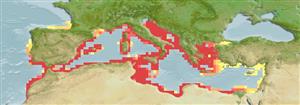Gastropoda |
Neogastropoda |
Muricidae
Environment: milieu / climate zone / depth range / distribution range
Ecology
Benthic; depth range 1 - 200 m (Ref. 105998). Subtropical, preferred 20°C (Ref. 107945); 45°N - 30°N, 10°W - 36°E
Eastern Atlantic and the Mediterranean: from Portugal to central Morocco in the Atlantic, and east to Lebanon. Introduced in Atlantic Spain.
Length at first maturity / Size / Weight / Age
Maturity: Lm 5.6, range 4 - ? cm Max length : 10.8 cm ShL male/unsexed; (Ref. 127250); max. published weight: 79.70 g (Ref. 127250)
Has high economic value since ancient times because it is used to produce a purple dye (Refs. 78459, 78460 and 78461). Carnivorous and feeds on bivalves and other gastropods (Ref. 2532).
Showed an annual reproductive cycle in the Catalan coast. The reproductive cycle had two peaks (April and June -July) but the first one seems to be less important because the number of immature females is higher than the mature ones.
Museum of Natural History in Paris. 2005. (Ref. 1056)
IUCN Red List Status (Ref. 130435)
CITES status (Ref. 108899)
Not Evaluated
Not Evaluated
Threat to humans
Human uses
Fisheries: commercial
| FishSource | Sea Around Us
Tools
Internet sources
Estimates based on models
Preferred temperature
(Ref.
115969): 16.2 - 21.6, mean 19.3 (based on 132 cells).
Prior r = 1.01, 95% CL = 0.67 - 1.52, Based on 2 full stock assessments.
Vulnerability
Low vulnerability (10 of 100).
Price category
Unknown.
Nutrients: Calcium = 126 [75, 177] mg/100g; Iron = 4.79 [1.67, 7.92] mg/100g; Protein = 15.9 [14.8, 16.9] %; Omega3 = 0.331 [0.263, 0.400] g/100g; Selenium = 57.8 [48.5, 67.2] μg/100g; VitaminA = 0 μg/100g; Zinc = 1.97 [0.92, 3.02] mg/100g (wet weight).
